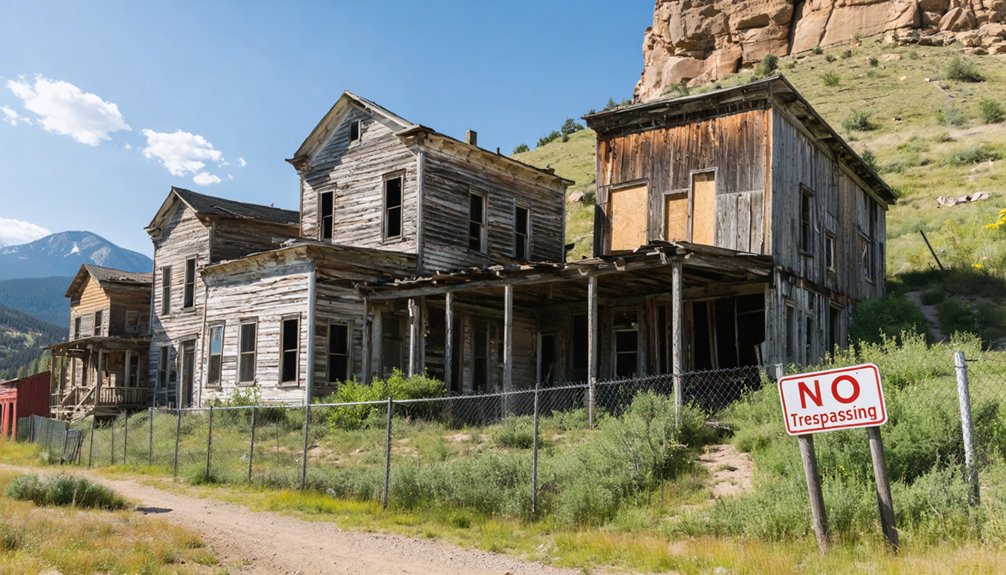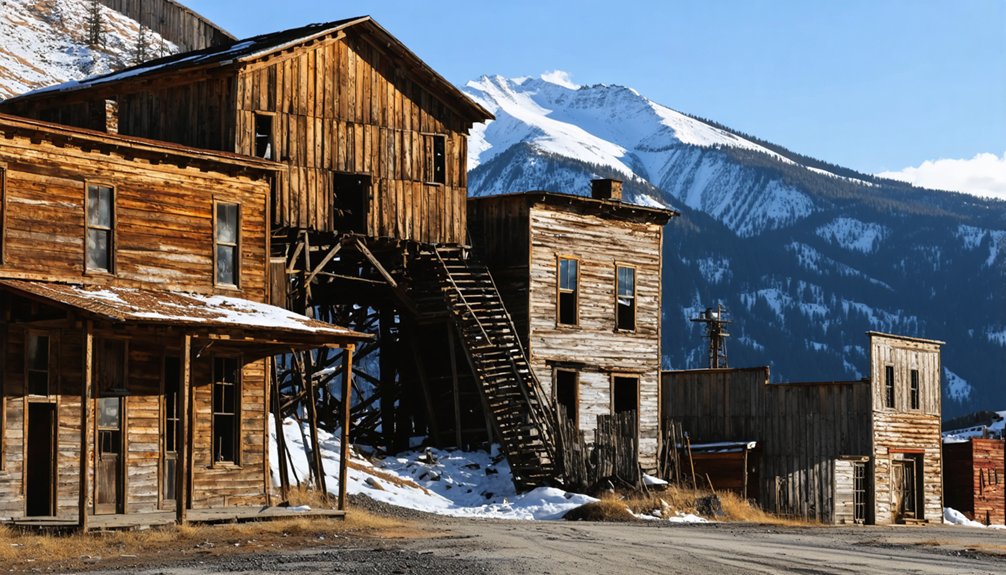Gilman, Colorado became a ghost town in 1984 when the EPA forced evacuation due to severe toxic contamination from a century of mining operations. Founded during the 1886 silver boom, it evolved into a company town under New Jersey Zinc Company, which extracted approximately 10 million tons of ore. Despite cleanup efforts beginning in 1988, the abandoned site remains heavily polluted with eight million tons of contaminated materials. The town’s fascinating yet tragic history reveals America’s complex relationship with industrial progress.
Key Takeaways
- Gilman was once a thriving mining town established in 1886 during Colorado’s Silver Boom, reaching a peak population of 1,500.
- The Eagle Mine produced zinc, gold, silver, and lead for nearly 100 years before operations ceased in 1984.
- Environmental contamination from mining led to EPA Superfund designation in 1986, with 8 million tons of toxic waste remaining.
- Now abandoned, Gilman sits perched above Eagle River Canyon with decaying structures from its industrial past still visible.
- Despite redevelopment attempts, including a $4 billion ski resort proposal, remediation costs and contamination continue to prevent revival.
The Silver Boom Origins of Gilman (1886-1900)
While numerous mining communities dotted Colorado’s landscape during the late 19th century, Gilman emerged as a particularly notable settlement when John Clinton established it in 1886 amid the fervor of the Colorado Silver Boom.
Clinton, a prospector and judge from nearby Red Cliff, strategically developed this company town to keep workers close to the profitable Iron Mask and Ground Hog mines.
Gilman’s community growth was remarkably swift—by 1887, it boasted essential infrastructure including a hotel, general store, and newspaper.
Silver mining operations on Battle Mountain yielded tremendous wealth, with ore valued at approximately $8 million by 1900.
Though a devastating fire in 1899 destroyed significant portions of the town, Gilman had already established itself with a peak population potentially exceeding 1,500 residents during the boom years. For researchers seeking additional information, specific historical details can be found by consulting the disambiguation page that directs to various Gilman-related articles.
Mining Empire: A Century of Lead and Zinc Production
You’re exploring what was once Colorado’s most significant zinc-producing region, where New Jersey Zinc Company transformed scattered mines into an industrial powerhouse spanning 70 miles of underground tunnels beneath Battle Mountain.
This vast subterranean network facilitated the extraction of approximately 10 million tons of ore, yielding 858,000 tons of zinc alongside substantial quantities of silver, gold, copper, and lead until operations ceased in 1984.
The Eagle Mine stood as the cornerstone of this mineral empire, serving as Colorado’s premier zinc source for over six decades while supporting an entire company town whose prosperity rose and fell with metal market fluctuations. The mining operations produced exceptional mineral specimens including beautiful jet black sphalerite crystals that are now preserved in various collections. The town’s dramatic location above Eagle River Canyon provided a strategic position for the mining operations, with processing mills situated at lower elevations.
Battle Mountain’s Underground Kingdom
Beneath the rugged terrain of Battle Mountain lies one of Colorado’s most impressive mining networks, a vast underground domain that shaped the economic destiny of Gilman for nearly a century.
The engineering marvel comprised approximately 70 miles of tunnels spanning 20 levels, with vertical shafts extending thousands of feet into the mountain’s core.
You’d find remarkable mining technology throughout this subterranean domain—four roasting and magnetic separation plants, an underground mill, and an elevator connecting directly to Gilman.
The underground innovations allowed miners to extract over 13 million tons of ore, yielding 1.8 billion pounds of zinc and 67.6 million ounces of silver.
The Newhouse tunnel and Wilkesbarre shaft provided access to this labyrinthine system that stretched 8,500 feet down dip and along 9,000 feet of strike.
The site featured impressive geological diversity with numerous mineral types including native gold, copper, and rare sulfides like galena and sphalerite.
By 1930, while still producing silver, the operation had strategically shifted its focus to zinc mining as the economic mainstay of the region.
Industrial Backbone Until 1984
For nearly a century, Gilman’s industrial backbone rested on its prolific zinc and lead production, evolving from humble beginnings during the 1886 Colorado Silver Boom into one of the state’s most significant mining operations.
Under New Jersey Zinc Company’s control after 1912, mining techniques advanced dramatically as they consolidated multiple smaller operations into the expansive Eagle Mine. The operation pivoted from surface oxide ores to deeper, more complex sulfide deposits, transforming Gilman into Colorado’s premier zinc production center.
By 1972, the district had yielded an astounding 10 million tons of ore, including 858,000 tons of zinc and 148,000 tons of lead, valued at approximately $328 million.
This industrial juggernaut supported hundreds of workers until 1984, when environmental concerns finally halted operations, ending Gilman’s remarkable century-long reign as a mining powerhouse.
Tunnels Spanning 70 Miles
The industrial might of Gilman rested upon an extraordinary subterranean labyrinth that few visitors ever glimpsed. Beneath your feet, over 70 miles of tunnels penetrated Battle Mountain, reaching depths of 2,800 feet and connecting multiple operations including the Eagle and Belden mines.
This engineering marvel evolved from primitive hand-dug passages to sophisticated networks utilizing mechanized drilling and electric equipment. The tunnel engineering incorporated timber supports, ventilation systems, and an innovative underground flotation mill—technological triumphs of their era.
These advanced mining techniques yielded over 12 million tons of ore, establishing Gilman as Colorado’s zinc powerhouse. The town was developed by John Clinton, a prospector and judge who invested heavily in mining operations to attract workers to the area. The New Jersey Zinc Company later became the primary operator and transformed Gilman into a major producer of zinc and lead throughout Colorado.
You’re witnessing the remnants of America’s industrial ambition—a subterranean city that fueled national defense during WWII before environmental realities eventually caught up with this once-thriving operation.
Life in a Company Town: The New Jersey Zinc Era
When New Jersey Zinc Company entered Gilman in 1912, it marked the beginning of a transformative era that would reshape the community’s economic and social fabric for decades to come.
Within years, the corporation acquired all principal mines—including the Iron Mask, Colorado’s largest zinc ore body—and the entire townsite.
Life under corporate ownership meant surrendering autonomy to company policies that governed nearly every aspect of daily existence.
You’d live in company housing, shop at company stores, and rely on company-provided recreation facilities.
Community dynamics shifted dramatically as tensions emerged between longtime residents and new management.
The once-independent mining town became a classic example of corporate paternalism, with employment, housing, and social life inextricably linked to New Jersey Zinc’s fortunes and decisions.
Labor disputes in the 1950s reflected growing resentment toward this arrangement, similar to issues that sparked the famous Empire Zinc strike of the same decade.
Environmental Devastation and the Superfund Designation

You’ll find Gilman’s most troubling legacy in the devastating environmental contamination that prompted its EPA Superfund designation in 1986, with approximately eight million tons of mine waste containing lead, zinc, cadmium, arsenic, and manganese poisoning the surrounding ecosystem.
CBS Operations, Inc., as the responsible party for New Jersey Zinc Company’s century of mining activities, implemented extensive cleanup efforts beginning in 1988 that included waste relocation, tailings capping, and containment systems to protect the Eagle River and local groundwater.
Despite the EPA declaring the remediation largely successful by 2000, the ecological damage from 70 miles of underground tunnels and eight major tailings piles continues to influence redevelopment possibilities, demonstrating the persistent environmental costs of historical mining practices.
The town’s final closure in 1984 came after toxic conditions made it unsafe for continued habitation, ending nearly a century of mining operations that had once made it Eagle County’s most successful settlement.
Toxic Legacy Revealed
Beneath the abandoned buildings and rusting industrial equipment of Gilman lies a toxic legacy that ultimately sealed the mining town’s fate.
For over a century, mining operations released massive quantities of lead, zinc, cadmium, arsenic, and manganese into the environment, contaminating surface water, groundwater, and soil.
The scale of toxic exposure is staggering—eight million tons of mine waste spread across 235 acres, including 70+ miles of underground tunnels.
You’ll find this mining impact affected the entire ecosystem, with the Eagle River serving as a major pathway for contaminant dispersal.
The EPA’s 1986 Superfund designation followed Colorado’s 1985 legal action against former owners.
Cleanup Efforts Assessed
Following the discovery of Gilman’s extensive environmental damage, the Environmental Protection Agency formally designated the abandoned mining town as a Superfund site in June 1986, marking the beginning of a complex remediation journey.
The cleanup assessment identified heavy metals including lead, zinc, cadmium, and arsenic as primary contaminants across the 235-acre site.
Remediation strategies implemented include flooding mine workings to reduce airborne hazards, stabilizing tailings piles, and extensive revegetation efforts. By 2000, authorities had addressed most immediate toxic concerns, though monitoring continues today.
You’ll find the site remains off-limits due to institutional controls preventing public access and potential exposure to residual contamination.
Despite significant progress, challenges persist – particularly the risk of heavy metal mobilization during rainfall events that could threaten the adjacent Eagle River ecosystem.
Ecosystem Impact Continues
The environmental devastation at Gilman extends far beyond the initial cleanup assessments, with profound ecological consequences that persist despite remediation efforts. You’ll find visible evidence of pollution persistence in the orange sludge and mineral crusts coating the Eagle River’s bed, signaling ongoing leaching from deteriorating mine infrastructure.
Despite decades on the National Priorities List, ecosystem recovery remains severely hampered. The 235-acre site still contains approximately 8 million tons of contaminated materials, preventing natural revegetation and creating barren landscapes where wildlife can’t safely return. The area requires extensive earth-moving efforts to address the scale of contamination effectively.
Bioaccumulation of heavy metals—including cadmium, chromium, and arsenic—continues to threaten surrounding habitats, with animal remains near the town bearing silent testimony to these toxins’ deadly effects. Meanwhile, contaminated runoff threatens downstream ecosystems, extending Gilman’s toxic legacy well beyond its abandoned boundaries.
The Final Exodus: How Gilman Became a Ghost Town

While many mining towns in Colorado experienced gradual decline, Gilman’s transformation into a ghost town occurred swiftly and decisively in 1985 as environmental concerns reached a critical threshold. The Battle Mountain Corporation enforced the final evacuation in spring 1985, ending nearly a century of continuous mining operations since 1886.
You’d find the emotional impact profound among residents who were forced to abandon their homes rapidly—buildings left intact but deserted.
The EPA’s designation of 235 acres as a Superfund site in 1986 formalized what locals already knew: eight million tons of mine waste had rendered their town uninhabitable.
Economic factors accelerated this exodus, as declining profitability and mounting environmental cleanup costs made continued operations financially untenable, permanently transforming this once-thriving community.
Battle Mountain’s Hidden Danger Zone: Current Conditions
Beneath the picturesque facade of abandoned mining structures, Battle Mountain harbors an invisible yet pervasive threat—toxic contamination that has rendered Gilman a permanent danger zone since its EPA Superfund designation in 1984.
Toxic legacies linger beneath Gilman’s weathered structures, an invisible menace transforming history into hazard.
Despite cleanup efforts concluding around 2000, the environmental hazards persist, with lead, zinc, and copper mining runoff contaminating groundwater and soil systems.
Your curiosity about this historical site must confront stark realities:
- Trespassing is actively prosecuted, with authorities vigilantly protecting public safety
- Structural instability compounds chemical dangers, with vandalism accelerating deterioration
- Warning signage and fencing mark boundaries of this privately-owned toxic landscape
While Highway 24 offers distant viewpoints, direct access remains prohibited.
The site stands as a cautionary monument to industrial fallout—a freedom lost to environmental negligence that transformed a thriving community into an uninhabitable wasteland.
Failed Dreams: Redevelopment Plans and Future Prospects

Despite Gilman’s toxic legacy and legal restrictions, ambitious developers have envisioned rebirth for this contaminated ghost town. Most notable was Edward Ginn’s audacious $4 billion ski resort concept, which gained unanimous approval from Minturn’s Town Council in 2008 despite community sentiments that oscillated between economic optimism and preservation concerns.
Federal legislation providing liability protection for developers of polluted lands initially facilitated this vision. However, redevelopment challenges proved insurmountable—groundwater contamination, hazardous waste remediation costs, and complex regulatory hurdles ultimately forced Ginn’s withdrawal in 2009.
Since then, Crave Real Estate Ventures manages the property, but no viable plans have materialized. As Gilman remains strictly off-limits, its prospects hinge on prohibitively expensive environmental cleanup while it continues attracting explorers fascinated by its decay—an ironic indication of humanity’s industrial hubris.
Frequently Asked Questions
Are There Any Documented Paranormal Activities or Ghost Sightings in Gilman?
No credible documentation exists. You won’t find verified ghost sightings in official records, and paranormal investigations lack substantiated evidence. Claims remain anecdotal, while trespassing concerns dominate actual discourse about the location.
What Happened to the Personal Belongings of Evicted Gilman Residents?
Most resident belongings—nearly 100% of personal artifacts—remain frozen in time, left behind during the hasty 1984-85 evacuation. You’ll find these untouched resident memories slowly deteriorating on restricted property.
Did Any Former Residents Organize Reunions After the Town’s Abandonment?
Based on available evidence, you won’t find documented reunion events among former residents after Gilman’s abandonment. The forced eviction, hazardous conditions, and dispersed population effectively prevented organized commemorative gatherings from materializing.
What Wildlife Has Reclaimed the Abandoned Gilman Townsite Today?
Nature abhors a vacuum. You’ll find mule deer, coyotes, black bears, and foxes dominating wildlife sightings, while birds like robins and hawks have established habitats despite minimal natural habitat restoration in the contaminated environment.
Were Any Movies or Television Shows Filmed in Gilman?
You won’t find cinematic history at this location. No documented major movies or television shows were filmed in Gilman, as its toxic designation, private ownership, and structural hazards prevent its use as film locations.
References
- https://www.uncovercolorado.com/ghost-towns/gilman/
- https://www.legendsofamerica.com/gilman-colorado/
- https://www.denvergazette.com/2025/07/07/the-storied-past-of-a-toxic-ghost-town-youre-not-allowed-to-visit-in-colorado-2da43f09-87e4-42a8-bbca-e57f2e95dc76/
- https://www.vailmag.com/news-and-profiles/2019/10/a-look-back-at-gilman
- https://abandonedforgottendecayed.com/2016/07/09/the-abandoned-mining-town-of-gilman-colorado/
- https://www.youtube.com/watch?v=q4X9xDc2_lY
- https://ruralresurrection.com/ghost-towns-gilman-colorado/
- https://en.wikipedia.org/wiki/Gilman
- https://bachelorgc.clubhouseonline-e3.com/Members-Only/History
- https://www.mininghistoryassociation.org/Journal/MHJ-v22-2015-Brill.pdf



